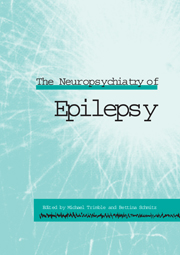Book contents
- Frontmatter
- Contents
- List of contributors
- Part I Background
- 1 Introduction
- 2 Neuropsychiatric disorders in epilepsy – epidemiology and classification
- 3 Limbic connectivity: anatomical substrates of behavioural disturbances in epilepsy
- Part II Clinical aspects
- Part III Cognitive aspects
- Part IV Nonepileptic attacks
- Part V Treatment complications
- Part VI Treatment
- Index
2 - Neuropsychiatric disorders in epilepsy – epidemiology and classification
Published online by Cambridge University Press: 05 October 2010
- Frontmatter
- Contents
- List of contributors
- Part I Background
- 1 Introduction
- 2 Neuropsychiatric disorders in epilepsy – epidemiology and classification
- 3 Limbic connectivity: anatomical substrates of behavioural disturbances in epilepsy
- Part II Clinical aspects
- Part III Cognitive aspects
- Part IV Nonepileptic attacks
- Part V Treatment complications
- Part VI Treatment
- Index
Summary
Introduction
The association between epilepsy and psychiatric disorders has a long and chequered history. For centuries seizures were considered to be a form of demonic possession. Beginning late in the nineteenth century, considerable attention has been directed towards cataloguing, describing and understanding disorders at the interface between epilepsy and psychiatry, particularly by European neurologists and psychiatrists. However, it is only in the past few decades that any attention has been paid to the epidemiology of these disorders. Similarly, aside from some early attempts by European physicians, there have been no efforts to develop an operational classification of psychiatric disorders in epilepsy (Schmitz and Trimble, 1992 for a review).
The paucity of epidemiological research at this interface, and the failure to develop an operational international system of classification, is in stark contrast with developments both in epilepsy per se, and in mental health research. The epidemiology of epilepsy has been well studied in many countries and considerable data (both descriptive and analytical) are now available. Indeed, epilepsy has been subject to the gamut of epidemiological research including cross-sectional, case-control and cohort studies (Hauser, 1998). Similarly, operational international systems of classifying epilepsy and its syndromes have been developed both by the Commission on Classification and Terminology of the International League Against Epilepsy (1989), and the World Health Organization (1967), and are used by epileptologists around the world.
- Type
- Chapter
- Information
- The Neuropsychiatry of Epilepsy , pp. 5 - 17Publisher: Cambridge University PressPrint publication year: 2002
- 8
- Cited by



